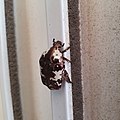| Protaetia aurichalcea | |
|---|---|
 | |
| Scientific classification | |
| Kingdom: | Animalia |
| Phylum: | Arthropoda |
| Class: | Insecta |
| Order: | Coleoptera |
| Suborder: | Polyphaga |
| Infraorder: | Scarabaeiformia |
| Family: | Scarabaeidae |
| Genus: | Protaetia |
| Species: | P. aurichalcea |
| Binomial name | |
| Protaetia aurichalcea (Fabricius, 1775) | |
| Synonyms | |
| |
Protaetia aurichalcea is a species of flower-chafer beetle in the family Scarabaeidae. It is found in Asia.
The ground colour of the beetle is bronze with white markings on the elytra. Males have spiny apical elytral angles showing up as a raised ridge along the elytral suture. [1] Like other flower-beetles, adults visit flowers but they are known to sometimes visit beehives and feed on pollen collected. [2] [3]



